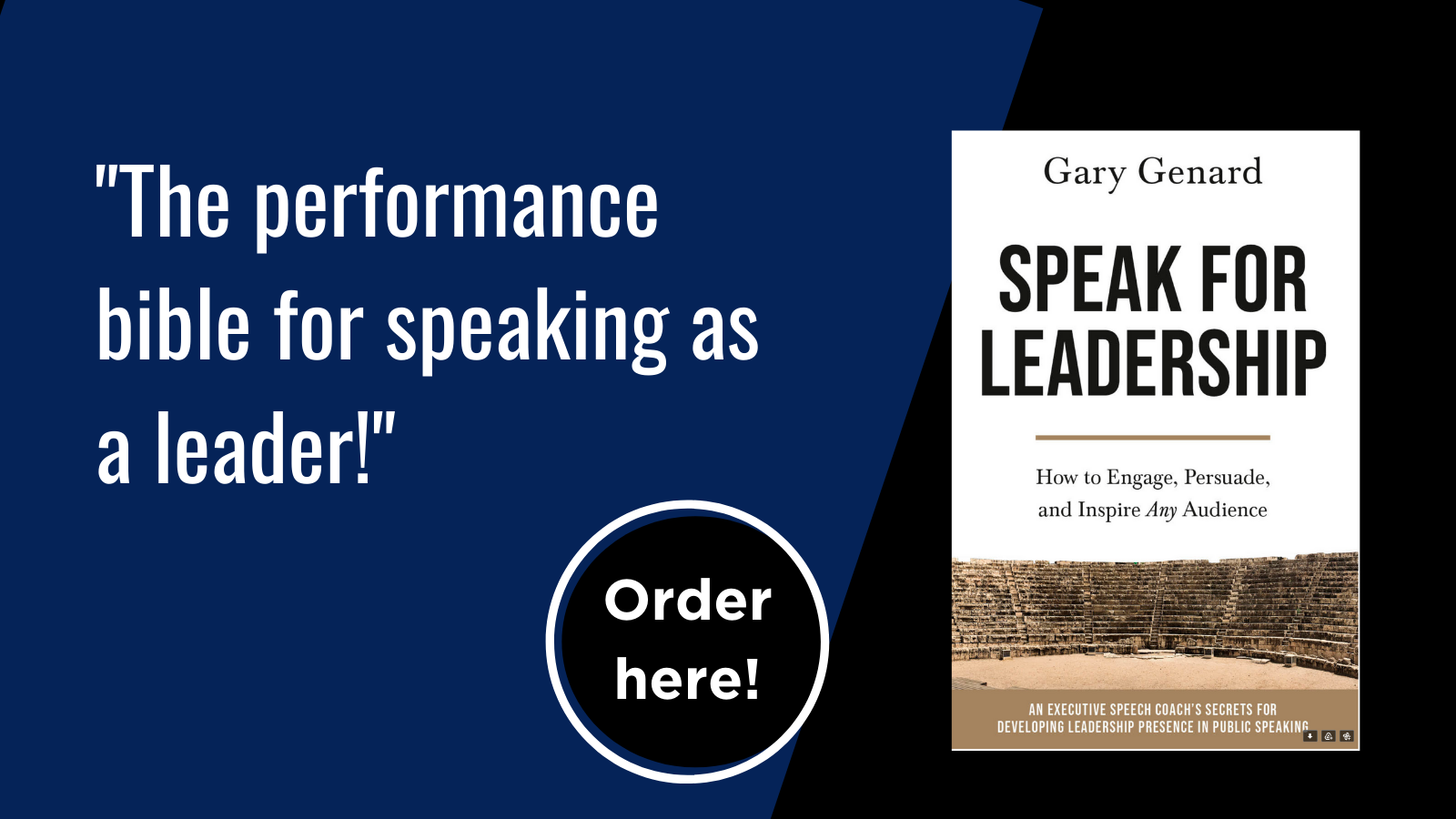 Photo by Riccardo Annandale on Unsplash
Photo by Riccardo Annandale on Unsplash
Are you a current or aspiring leader who can command a room? Here's a key question and the answer you need: 'Can you learn leadership presence? YES!'
Mastering the art of speaking to others is the most important skill you can acquire as a professional. It’s always been that way—from ancient times to today’s virtual environments. Exciting things can happen when you as speaker take the stage.
But such magic isn’t limited to influencing public speaking audiences. Certainly, if you’re an executive, entrepreneur, motivational speaker, CEO, or anyone who speaks at meetings, you need powerful techniques for reaching and moving listeners. And, if you’re a musician, dancer, singer, or other in-person performer, you also need a reliable and impactful approach to going about your craft.
Want to know more about commanding a stage and inspiring listeners? Get my new book about succeeding in-person and virtually, Speak for Leadership. Order below!
That’s exactly why I wrote my latest book, Speak for Leadership, which is all about performing at your best. Now, if there’s one thing you need to understand to touch people’s lives, it’s that you have the power to do so through how you speak to and influence them. You're always performing when you deal with others. So, you need to know how to bring your best self “on stage” when it comes to sharing the things that you’re passionate about.
Therefore, the first important lesson for speaking as a leader is this: you can learn the presence that will allow you to do this.
Here's more on unlocking your natural talents to speak with impact! It's my Free ebook, 12 Easy Ways to Achieve Presence and Charisma. Get it today!
Because I’m an actor and speech coach, I focus on how you can accomplish this level of presence on the public speaking stage: ‘stage presence.’ The focus we're talking about here, however, is not on getting listeners turned on to the material of your speech or presentation, necessary as that is. It's about getting audiences passionate about you as a performer in a way that leads directly to influence.
Reaching People Through Your Performance
And why wouldn’t audiences feel that way? Whatever business or professional information you discuss when you speak, you are absolutely unique. You’re literally the only person in the world who can say what you need to say, the way you’re able to say it.
Listeners don’t separate the message and the messenger. If they like you, they will be much more open to what you’re saying or showing them. Equally exciting: performance is the most powerful medium through which to reach people about anything. It’s the reason people like me go into acting. Ultimately, it’s also the reason why you are willing to speak to groups of total strangers if it means getting your message out.
So, learn how to knock everyone's socks off when you speak! Download my Free resource, "Great Speaking? It's About Performance Over Content."
You make it all come alive in a way that’s simply not possible otherwise.
That’s the idea of performance. It doesn’t matter whether it’s live, part of a video conference, or even on a recorded webinar. In every one of those cases, it’s you, speaking in the moment when you are heard or recorded, conveying the importance and immediacy of your topic. To the extent that audience members get why any of it matters, it’s you that’s making that happen.
That’s the reason you need as much leadership presence as you can muster.
But here’s the really good news: you can learn to be fully present and exciting when you speak, even if you think—especially if you think—that it involves some kind of aura you just don’t possess. Speaking with presence in order to lead is a skill like any other, one that you can understand and develop.
Are you ready to take that journey?
For one thing, speaking as a leader demands laser-like focus. Learn how it's done! Get my Free cheat sheet, "Leadership Skills: 10 Focusing Techniques for Public Speaking."
What is Speaking Presence?
One of the challenges of public speaking has always been that “the rules” of effective performance tend to be too constrictive and custom-bound. In the U.S., we’ve gone from grand nineteenth-century oratory, to the currently fashionable talks we see online. If TED Talks are all you watch, for instance, you may think that the only way to give a good speech is to stand inside a red circle and talk for 18 minutes.
But true artists break rules . . . and the best ones make the rules. Although, we can’t all be artists or groundbreakers, our personal goal should never be to speak to a formula. We can have this outlook even while understanding that conferences, panels, and other events have carefully thought-out schedules and time slots for speakers that we must follow.
Where’s the balance? The truth is the exceptional speaker creates something unique and valuable within the dictates of the medium, like a poet in a sonnet or haiku. Connecting with one’s audience and bringing about positive change is what matters, whatever the venue or specific information in your speech.
Get good at shaping your message so you meet listeners' expectations! Download my Free cheat sheet, "Leadership Skills: 5 Essential Speaking Techniques."
Well, then, how do you achieve that connection? At this point, we really need to know what we mean by “presence,” even if it’s not a hard-and-fast definition. This phrase is extremely hard to define.
So, how do we gain a sense of the special and transformative nature of stage presence in speaking for leadership? We can talk about the “passion, confidence, and comfortable enthusiasm”1 we recognize in those who display it. A contributor to Dance Magazine said this about it: “It’s the something that draws your eye to the dancer—the sparkle, the shine, an energy that pulls focus, be it subtly or with a brazen demand.”2 When practiced with great skill, it can turn a performer in any medium into a kind of mesmerist who invisibly weaves a spell right in front of us.
The great eighteenth- and nineteenth century German dramatist Johann Wolfgang von Goethe made it a central concept of his “Rules for Actors” when he wrote:
An actor standing alone on the stage should remember that he is called to fill out the stage with his presence, and this is so much the more when the attention is focused solely upon him. . . . The stage is to be regarded as a figureless tableau for which the actor supplies the figure.3
The actor “is called to fill out the stage with his presence.” And the stage itself is a “figureless tableau for which the actor supplies the figure.” Imagine that Goethe is discussing public speaking rather than acting. Can you think of a more powerful image of how your presence on stage allows you not only to deliver information, but also to move audiences?
The Importance of Energy in Public Speaking
A good way to grasp this idea is to think in terms of energy. When someone with presence enters a room, the level of energy somehow feels different. People may stop what they’re doing to look. They feel that something interesting just happened or is about to happen. It’s as though a spotlight were shining on that person, one that follows them wherever they go.4 (In the theater, in fact, we have a term for this type of spotlight: it’s called a “follow spot.”)
People with stage presence carry an absolute air of authority, but it always comes from them just being themselves. We can call this, being themselves at their best; and so, it must become you, being yourself at your best. This concept is important to grasp. Otherwise, it can feel like too much of a hurdle to suddenly become someone who makes everyone’s head turn when you walk into a room.
It's much easier to be authentic when you're calm and confident! Here's a great resource: my Free cheat sheet, "How to Calm Your Nerves Before Speaking." Download it now!
Becoming Comfortable Being Yourself. Your first action, then, for gaining true presence as a speaker, is to become comfortable being yourself. There’s no more important bar to clear than that first one. In fact, trying to be “better” or different from who you really are will inhibit your ability to develop any real magnetism on stage. People are drawn to others who are completely themselves—totally authentic and in the moment. That’s probably because many of us have trouble being those two things even when we’re off stage!
This is where the world of acting can help. Did you ever wonder why we believe actors whose names we know well (Christian Bale, say, or Cate Blanchett) are really the characters they’re playing? It’s not due to artifice—as we might think at first—but truth. That’s because instead of trying to give a towering performance, the experienced actor simply plays the life of the character, moment by moment as it unfolds in the script. Actors and actresses have the skill of suspending their own knowledge of what is about to happen in a scene, so they can react to it honestly and realistically. (It’s called “the illusion of the first time”.) Since they are totally in the moment, they can react organically to what is happening right now.
What emerges is a true emotional response by the character to that moment. What we don’t see is all the character study and the invention of a life for that person offstage, discussions with the director about intentions and motivations, the exhausting rehearsals, and all the rest.
This is exactly the same kind of truth and authenticity you need for developing speaking presence! In your case, it involves conveying the truth of what you’re saying to listeners. But just as with the actor, it’s about that truth, not giving a great performance. This is a bedrock principle to keep in mind in speaking for leadership.
Consequently, BEING PRESENT is the first requirement for succeeding with audiences, whether you’re an actor or a speaker.5 It truly is all about connecting. That is what is behind the first of my two definitions of public speaking presence, just for you (to be accepted as absolutely not the last word on the subject):
The convergence of your mental, emotional, physical, and spiritual selves as you speak while attempting to connect with others.
My second definition, which I hope is equally valid, is much more down to earth:
You, talking in a way that genuinely moves an audience without being phony.
So, set your feet firmly on the stage or floor, then fly, taking your audience along on every beat of your wings.
1 Amy Cuddy, Presence (Boston: Little, Brown and Company, 2015), 26.
2 Theresa Ruth Howard, "Improving stage presence," Dance Magazine v. 82, issue 12. (Dec. 2008). http://link.galegroup.com/apps/doc/A190462060/PPFA?u=mlin_m_
minuteman&sid=PPFA&xid=9e0d2fbb.
3 Johann Wolfgang Von Goethe, "Rules for Actors" (1803, 1824), translated by John Oxenford, 86, 83. https://sites.broadviewpress.com/lessons/DramaAnthology/ GoetheRulesForActors/GoetheRulesForActors_print.html.
4 Kathy Lubar and Belle Linda Halpern, Leadership Presence (New York: Gotham, 2003), 1
5 Lubar and Halpern, 19.
The above article is excerpted from my new book, Speak for Leadership. Click here or below to learn more and to get your copy!
You should follow me on Twitter here.
Gary Genard is an actor, author, and expert in public speaking training and overcoming speaking fear. His company, Boston-based The Genard Method offers live 1:1 Zoom executive coaching and corporate group training worldwide. In 2022 for the ninth consecutive year, Gary has been ranked by Global Gurus as One of the World’s Top 30 Communication Professionals. He is the author of the Amazon Best-Seller How to Give a Speech. His second book, Fearless Speaking, was named in 2019 as "One of the 100 Best Confidence Books of All Time." His handbook for presenting in videoconferences, Speaking Virtually offers strategies and tools for developing virtual presence in online meetings. Contact Gary here.




